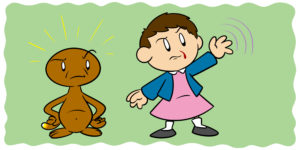What do you want as a writer? To produce great work and find your fair share of readers – that’s a given – but what about on a deeper level? Are you the type of writer who wants to change the world, or do you just love words and take joy in making them dance?
It may seem like a question without any practical benefits, but harnessing your artistic drive is a process that begins with understanding just what exactly you’re getting out of your craft. That’s what we’ll be exploring in today’s article, and we’ll be using an elephant and a termite to do it.
Elephant writing and termite writing
Elephant writing and termite writing are just terms for two different sets of priorities when creating art. Elephant writing (and really any elephant art) is about subject matter. It describes writing where the intent is to discuss an idea that’s relevant to the real world; to address the elephant in the room.
Termite writing, on the other hand, is about form. It describes writing where the intent is to engage with the art form of literature, concerning itself with doing new things in new ways.
There’s two types of artists. Artists who are interested in the content itself, the story, and artists who are making art that comments on the medium itself. The history of the medium, how it’s been used; for example, a Jackson Pollock painting is a bit of both, but it’s more on the side of, when you see it, at the time it first came out, you would see a Jackson Pollock painting with someone who has knowledge of art history, and your first thought would be, ‘This flies in the face of structural conventions,’ not, ‘Which character does that yellow splodge represent?’ It’s not content-based, it’s called ‘formalism.’ And I just think it’s really interesting that, in every field, people wind up at that. It’s true-true-true, and it’s good to know which one you are, if you’re an artist.
– Michael Swaim and Alex Schmidt, Kurt Vonneguys, ‘Episode 21: Fates Worse Than Death’
Where elephant writing and termite writing are special is in describing an author’s artistic aspirations in terms of their place in the continuum of their medium. By this, I mean that every piece of literature exists as part of a timeline, with older writing before it and as-yet-unwritten work after it. As readers, a book’s place in the timeline is important because it provides vital context – Frankenstein is a great book that grows massively in importance when you consider how original it was for its time – but as writers, understanding our relationship to the timeline involves exploring what we’re trying to do as artists, how well we’re doing it, and whether it’s even worth doing.
Writing can be both elephant and termite, or at least have elements of both, but the difference boils down to whether a writer is trying to add to the discussion or add to the medium. Of course, the world needs both types of book, but it can only help your art to understand where your passion lies.
Elephant writing
Elephant writing is all about content. It deals in new ideas from new voices, offering readers a unique view on the world that they can’t find anywhere else. Elephant writing can still have great craft, but it’s less vital than the message, ideas, and/or emotional experience that the artist is trying to convey.
Angie Thomas’ The Hate U Give is a good example of elephant writing – a book aimed at a young audience and discussing a current social problem that’s still being grappled with by the society into which it was released. Kristen Roupenian’s short story ‘Cat Person’ is similarly current, playing off an emerging social mood that is more open to her core conceit than ever before.
The sci-fi of authors like Harlan Ellison and Philip K. Dick is likewise elephantine, albeit in a different way. These giants of hard sci-fi addressed social issues of their time, but they also imagined whole new technologies, philosophies, and ways of being. Their intent was to present the reader with concepts that they’d never seen before and – on a good day – that no writer before them had ever envisioned in quite the same way.
But elephant writing doesn’t need to be so conceptually ambitious. Many authors want to tell fresh, vibrant stories that don’t feel quite like anything else. This is often the urge behind fairy tale retellings – the intent to retell something old in a way that enlivens it while maintaining the same sense of truth. Teen fiction exists in a constant state of elephant writing, not necessarily saying anything inherently new about what it’s like to be a teenager, but saying it in a unique way that allows each new generation to experience it individually and afresh. In this way, The Hunger Games is a surprisingly elephantine book despite offering nothing that can’t be found elsewhere.
If what thrills you about writing is the emotional communication, your ability to enflame your reader’s emotions and broaden their mind, it’s likely that you tend toward elephant writing.
While the subtler forms of elephant writing can be timeless, explicit elephant writing is something of a treadmill. Since you’re engaging with themes relevant to society as it currently exists, you’ve got to keep up to remain relevant. A lot of books that expressed incredibly forward-thinking attitudes at the time in which they were written are now thought of as simplistic or even retrograde, and the accusation isn’t unjust – as we progress, attitudes should age, and it’s the nature of new ideas to look silly in retrospect. The sci-fi of Philip K. Dick still has relevance, but his stories imagine a futuristic society still enmeshed in the idea of the professional husband and the housebound wife. No sincerely elephantine writing survives the march of time unscathed, but then again nor should it, and plenty of elephant writing is still held in high esteem, both for the message it preached at the time and its overall quality. To Kill a Mockingbird is still considered a masterpiece, and The Communist Manifesto isn’t exactly dead and forgotten, for all the new ideas that followed it.
This potential erosion by time is the gamble you take for a chance to seize the zeitgeist. The Hunger Games was a gargantuan hit because it seized on something true and urgent about the moment in which it was written. Most blockbuster fiction manages this to some degree – it’s not just good, it’s about now, and that gives it an electricity you don’t get any other way.
Elephant writing is also likely to be controversial. While termite writing is, in some respects, apolitical, elephant writing attempts to deal in new ideas, and that means everything is under the microscope. Few authors write to be loved by everyone, but by stepping into the arena of the new, you’re taking on a particular type of challenge.
J.A. Johnstone’s Trigger Warning was a subject of ferocious mockery upon its release not just because of the values it espouses – which are the same as many other books that didn’t invite the same reaction – but because it deliberately positioned its observations as relevant to the modern day. In its title, blurb, and subject matter, Trigger Warning declared itself as having something new to say. When it failed to live up to that promise, it very publicly fell on its face. Of course, the opposite is true; if you set out to offer something new and relevant and do exactly that, your book will be all the more impressive for it.
Termite writing
Termite writing is all about craft, but more than simply being well crafted, it attempts to contribute to its medium. It’s easy for passionate authors to look down on termite writing as heartless or automated, but it’s not an unemotional goal, it just sources beauty from craft before content. Of course, that’s not to say that the content isn’t there, just that it’s less vital than form in what the author is trying to accomplish.
Books like House of Leaves and The Unfortunates are very literal examples of termite writing. The latter is a book in a box, where the physically separate chapters are meant to be read in random order. This is an experiment in form – how to write a compelling story that isn’t bound by usual rules of continuity.
A more thematic example of termite writing can be found in the oeuvre of Robert Rankin. Rankin writes pseudo-bizarro fiction, mixing genres both in his body of work and within the books themselves. He uses consistent but seemingly random imagery (sprouts and Elvis reappear on multiple occasions), and while characters appear in multiple stories, they often seem not to remember earlier adventures. Rankin writes noir detectives who know they’re fictional, nursery-rhyme-themed stories that switch genre partway through, and books about preventing the end of the world where the world ends and then the story keeps going. Through this approach, Rankin breaks down the reader’s expectations of genre and continuity, allowing for genuine surprises in areas where most readers assume they have the lay of the land. This is termite writing not because it doesn’t subscribe to the norm, but because it deliberately subverts narrative tradition.
Another example is Flann O’Brien’s At Swim-Two-Birds, in which a group of characters attempt to escape the tyranny of their author. Again, O’Brien (the pen name of Brian O’Nolan) is deliberately interrogating the assumed barriers of form, something he does both as the author and in the attitudes of the characters themselves.
A good book may have three openings entirely dissimilar and inter-related only in the prescience of the author, or for that matter one hundred times as many endings.
– Flann O’Brien, At Swim-Two-Birds
Even subtler is the termite art of Patrick deWitt. Some of deWitt’s early writing shows deliberate experimentation with form – his debut novel Ablutions is an experimental, second-person series of character sketches and nightmarish vignettes that still works as narrative fiction – but has settled into a more traditional style since then. Still, deWitt’s focus is squarely on craft, and it’s clear from interviews that one of the things he most seeks to do in his writing is present the world with new sentences it has never seen before.
Part of becoming a writer is finding what it is you desire most from a book, and what moves you the most. I realized that what I was and am looking for is brilliance in dialogue. I’m also looking for a high level of craftsmanship on the sentence level. I know people for whom plot is everything, and the construction of the prose is secondary, but that’s alien to me. I don’t think I would read a book if it wasn’t beautifully made… once I realized what I was looking for as a reader that clarified for me my own goals as a writer.
– Patrick deWitt, Storgy, ‘Interview: Patrick deWitt’
While deWitt may not be trying to tell a story in random order or subverting the idea of beginnings and endings, he’s still trying to do something new on the level of form. If that’s what delights you about writing – the flips and tricks you can make words perform – it’s likely that you tend towards termite writing.
One of the benefits of termite writing is that, when it works, it’s mind-blowing. To show someone not just an idea they’ve never encountered before but a way of expressing ideas they’ve never encountered before is a show-stopper of a trick and the kind of thing that will endear you to a reader for life.
Termite writing also promotes a ferocious kind of ambition. Manny Farber’s essay on white elephant and termite art doesn’t quite correspond to our suggested use of the terms – his elephant writing is more about needless excess and style over substance – but the section below still applies.
A peculiar fact about termite tapeworm-fungus-moss art is that it goes always forward eating its own boundaries, and, likely as not, leaves nothing in its path other than the signs of eager, industrious, unkempt activity. … The most inclusive description of the art is that, termite-like, it feels its way through walls of particularization, with no sign that the artist has any object in mind other than eating away the immediate boundaries of his art, and turning these boundaries into conditions of the next achievement.
– Manny Farber, Film Culture, ‘White Elephant Art vs. Termite Art’
Once you’ve chewed through the old boundaries and set new ones, you know you can do it, and you’ll look at those new boundaries as a challenge rather than a cage. Termite art tends to sharpen the creative edge like nothing else, since it teaches authors to look beyond their current boundaries with envy and self-assurance. Every book Patrick deWitt writes shows clear and specific improvement on the last, and he started off well.
Unfortunately, the flipside of this approach is that termite art can often age poorly for readers. This can be seen in the generational approach to the sitcom Seinfeld. Seinfeld is classic termite art, experimenting with the storylines and resolutions that viewers could expect from a television comedy, but it was also a smash hit. That meant that, as time marched on, many of its boundary-smashing accomplishments were adopted into the mainstream, and so a modern audience approaches Seinfeld with significantly different expectations than when it was made.
Of course, appreciating any art form involves educating yourself and approaching work in context, but most readers aren’t literary historians, and it’s possible that if your work revolves around breaking boundaries, you’ll only ever be as relevant as your most recent book. Authors can struggle with this, but it’s particularly present in videogames, where technological and graphical breakthroughs are given primacy. Often, only the latest game in a series is worth playing on its own merits, since every prior game is rendered lacking in comparison. While less pronounced in literature, this can be a particular issue for nonfiction writers who repeatedly mine the same subject – there’s no point reading what you thought ten years ago when a more up-to-date version is available.
Ambitious termite writing is also particularly harsh on failures. While elephant writing is at least always new to someone, termite writing that doesn’t actually do anything new tends to feel both high-effort and lacking in purpose, which can be frustrating for readers. While Robert Rankin’s better books are impressive in their unpredictability, his worst efforts are frustrating, failing to offer satisfying conclusions or darting away from characters or even genres that the reader was enjoying. This, ultimately, points to the big risk of termite writing – the current boundaries were set for a reason, and it’s because that’s what readers understand and enjoy. Show them a new standard and they’ll be amazed, but fail and you fall short not just of your new standard but of the old one too.
The elephant and the termite
It’s overly grand to suggest that every author is an elephant or a termite. In my MasterClass review of R.L. Stine, I included the following quote:
You know, the truth is, I’ve written maybe three hundred and thirty books, and I haven’t written a single one from my heart, not one.
– R.L. Stine, ‘Introduction’, MasterClass
Stine doesn’t present as a termite writer, and while he does care that kids have something fun to read, that’s about as far as his elephant impulses seem to run. He’s a man who likes writing and knows what his audience finds exciting and scary, and that seems to be unhampered by any consideration of where his work fits into the expanding timeline of literature.
So, it’s not about deciding whether you’re an elephant writer or a termite writer, it’s about identifying whether you’re governed more by elephant or termite impulses and how you express that in your work. The best outcome of this is that you get a fresh, clear look at what’s going to satisfy you as an author. If you’re constantly fiddling with form, delighting when you get to construct something new, then it might be worth chasing that impulse and really experimenting with what writing can do. If you’re excited by your ability to contribute to the world around you, to really nail down your ideas and express them to others, then it might be worth asking how you can tailor your approach to make the most of that.
Want some concrete recommendations? Well, if you’re more of a termite writer, consider writing some kind of zine, experimenting with constrained writing (writing under pre-set conditions), or looking into bizarro or new weird fiction. The latter subgenres are all about breaking the rules, while creating a zine is a great way to suspend all your expectations of your own work and see what happens. If you’re more of an elephant writer, ask what you can do to put your work in front of people. Enter some competitions that require you to write now and try producing something that’s meant to be read straight away, like a blog, flash fiction, radical writing opportunities, or… well… actually, you should try writing a zine too, just for different reasons.
Literature is a big, fascinating field, and contrary to what you might have been told, we are still both telling new stories and finding new ways to tell them. Understanding what really fascinates you about writing, what you’re trying to do and who you’re trying to be as an author, doesn’t have to put you in a box, but it can give you the clarity you need to chase the things that will give you the most satisfaction.
Are you more of a termite writer or an elephant writer? Let me know in the comments, and check out Are You Writing For Systematic Or Empathetic Readers? for another way of looking at your personal style.





